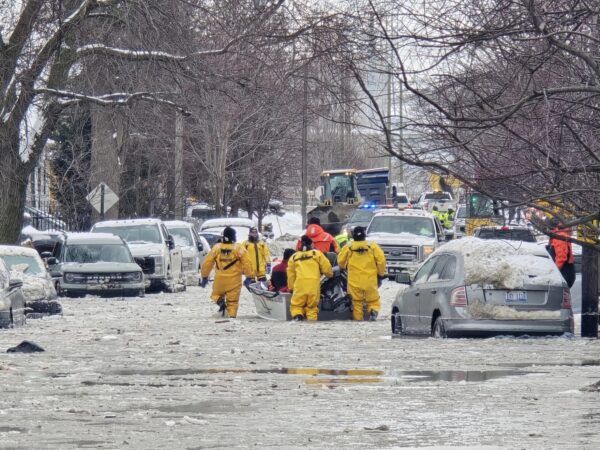
Great Lakes Moment is a monthly column written by Great Lakes Now Contributor John Hartig. Publishing the author’s views and assertions does not represent endorsement by Great Lakes Now or Detroit Public Television.
In southwest Detroit, evidence of environmental injustice can be found nearly everywhere, and communities of color and low wealth feel that polluting companies and government officials are not doing enough to address many long-standing environmental problems.
These communities are disproportionately exposed to polluted air, water and soil, and noise pollution. A recently published study in the journal Environmental Research has filled an important knowledge gap on the magnitude of the noise problem. This study found that traffic-related noise is widespread throughout southwest Detroit, and residents near truck routes, highway ramps and highways are disproportionately exposed to it.
Traffic noise is considered to be one of the worst environmental stressors for humans by the World Health Organization, second only to air pollution. Long-term exposure to elevated noise can cause hearing impairment and can affect sleep and physical and psychological health. Sleep deprivation is known to increase stress and elevate blood pressure, which can lead to coronary disease and heart attacks.
Researchers from the University of Michigan partnered with the Southwest Detroit Community Benefits Coalition to evaluate the noise impact of the trucks on their neighborhood. Southwest Detroit has many logistics centers and freight and manufacturing operations that receive nearly constant deliveries. Compounding the problem, trucks are allowed on predominantly residential streets as part of longtime zoning. And currently truck traffic has been rerouted through neighborhood streets as part of the new Gordie Howe International Bridge construction to be completed in 2024.
This study found noise levels on the porches of homes on the residential streets, currently being designated as truck routes, exceeded the 70-decibel guideline used by the Federal Highway Administration, and peak levels were far higher. Further, weekday noise measurements ranged between 55.3 to 73.8 decibels, with an average of 62.1 decibels, with the highest noise levels between 7-10 a.m. and 2-5 p.m. The differences between day and night noise levels at most residential sites were consistent with traffic volume patterns on local highways. The high noise levels were found near trucking routes.
Dr. Stuart Batterman, lead investigator on the study, stated that the bottom line from a management perspective is that “we need to have designated truck routes that avoid these neighborhoods.”
These researchers will continue to monitor noise levels over the next several years.
Southwest Detroit has also long been recognized for poor air quality, including both zip codes 48209 and neighboring 48217, which remains among the most polluted areas in the state. More than two dozen major industrial facilities surround the neighborhoods in 48209 and 48217, and trucks spew out considerable air pollutants. Air pollution has been linked to health impacts such as cancer, asthma, birth complications, Alzheimer’s disease and more. It typically impacts the most vulnerable in our society – children and elderly.
A recent Health Impact Assessment of this same area performed by the University of Michigan, Southwest Detroit Community Benefits Coalition, and Detroit Hispanic Development Corporation found that children have twice the rate of asthma and seniors have three times the Michigan asthma rate if they live near trucking roadways.
In 2021, the American Lung Association reported that despite improvements in air quality Metropolitan Detroit is still ranked the 12th most polluted city in the United States, based on year-round particle pollution. The region also experienced more days with dangerous spikes in short-term particle pollution.
“Residents have come to community meetings carrying oxygen tanks, and teachers stack inhalers for their students on their desks every day. Residents can’t open their windows without emissions’ dust covering their counters. This is normal for southwest Detroit,” said Simone Sagovac with the Southwest Detroit Community Benefits Coalition, which has worked on community studies and remedies.
“We have over 600-800 semi-trucks driving on some Southwest Detroit residential streets daily,” Sagovac said. “And our air has been in ‘nonattainment’ for years for multiple pollutants, and permits keep getting issued to pollute. We need decision-makers to act and direct resources to change the injustice.”
In a 2017 human health impact study, the University of Michigan’s School of Public Health and Detroiters Working for Environmental Justice showed that exposures to fine particulate matter, ozone, sulfur dioxide and nitrogen dioxide are responsible for more than 10,000 disability-adjusted life years per year, causing an annual monetized health impact of $6.5 billion.
Thomasenia Weston lives in a house in southwest Detroit just a few blocks from I-75. She raised her daughter and is now raising her two grandchildren in this house. All three generations suffer from severe asthma.
For Weston, this new study is just more scientific proof of the air and noise pollution she and her family must live with daily. There are also sink holes in front of her house that she feels are caused by the many heavy trucks passing on her street daily. The vibrations from the trucks have caused cracks in the foundation of her house that are now allowing stormwater to flood her basement and make it unusable. Weston notes:
“No one should have to live in such air, noise and stormwater pollution. The air and stormwater pollution and noise war going on outside my front door are affecting my sleep and causing me a lot of mental stress. We are human beings and deserve the same quality of life as everyone else without being poisoned, aggravated and unheard.”
Environmental injustice occurs when residents of low-income and minority communities are disproportionately burdened by environmental contamination and health risks. Environmental justice requires the fair treatment and meaningful involvement of all people regardless of race, color, national origin or income with respect to the development, implementation and enforcement of environmental laws, regulations, and policies.
The overlapping crises facing southwest Detroit will require integrated solutions that provide meaningful justice for all living in this area. There is a critical need to shine more light on and raise awareness of environmental justice in southwest Detroit, and support and build the capacity of organizations working in the trenches of environmental justice.
Organizations on the front lines of environmental justice in southwest Detroit include:
Detroit Hispanic Development Corporation
Southwest Detroit Community Benefits Coalition
Southwest Detroit Environmental Vision
Michigan Environmental Justice Coalition
Detroiters Working for Environmental Justice
Great Lakes Environmental Law Center
Community Action to Promote Healthy Environments
John Hartig is a board member at the Detroit Riverfront Conservancy. He serves as the Great Lakes Science-Policy Advisor for the International Association for Great Lakes Research and has written numerous books and publications on the environment and the Great Lakes. Hartig also helped create the Detroit River International Wildlife Refuge, where he worked as the refuge manager until his retirement.
Catch more on Great Lakes Now:
Great Lakes Moment: The US-Canada ecosystem-focused approach to restoration
Great Lakes Moment: Walleye frenzy on the Detroit River
Great Lakes Moment: A Great Lakes Way stretching from southern Lake Huron through Western Lake Erie
Featured image: Southwest Detroit (Photo Credit: Lauren Santucci)
2 Comments
-
There isn’t a single air pollutant monitored
by either MDEGLE or by Marathon Refinery in Detroit zip 48217 that
is anywhere close to the highest in the State of Michigan. Air quality
in Detroit zip 48217 is monitored by MDEGLE and it is not appreciably
different than other sites in the Greater SE Michigan area.The claims that Detroit zip 48217 is the ‘most polluted’ in Michigan or is the third
most polluted in the USA (claim made by AG Dana Nessel) are all false and
are urban myths, based on junk science and Detroit neighborhood bashing at its worse. These
false claims are rebutted by actual air quality science with monitoring reports
from MDEGLE Air Quality Division:https://www.michigan.gov/documents/deq/deq-aqd-amu-48217_air_monitoring_report_621859_7.pdf
https://www.michigan.gov/documents/egle/egle-aqd-amu-48217_air_monitoring_report_2019_655707_7.pdf
48209 is home to the Delray section of Detroit which has had the truthful
actual distinction over the last 50+ years as having the
worst air quality in the State of Michigan for the pollutant PM2.5.
In some years, Southeast Dearborn (monitor at Salinas School)
has had occasional annual average PM2.5 exceeding that measured
in Delray, but never consistently year to year.Here are the records for PM2.5:
https://www.michigan.gov/documents/deq/deq-aqd-amu-monitoring-pm25-24hr-summary_403178_7.pdf
https://www.michigan.gov/documents/deq/DEQ-AQD-PM25_summary_291638_7.pdf
As to this….
>>>>”In 2021, the American Lung Association reported that despite improvements in air quality Metropolitan Detroit is still ranked the 12th most polluted city in the United States, based on year-round particle pollution. The region also experienced more days with dangerous spikes in short-term particle pollution.”
This report purports to measure the present State of the Air, but their 2021 report uses data
from year 2017-2018-2019 and it isn’t a present-year, current 2021 (or even 2020) data evaluation.In their report, the American Lung Association takes the worst monitoring site for PM2.5 in the metropolitan Detroit area for PM2.5 ( which is for the 48209 monitor in Delray) and then makes the assumption that the entire SE Michigan metro area has the same exposure…..which is a gross overestimation of the population exposure to PM2.5, since the other monitoring results from other area PM2.5 monitors is not used in the analysis. Such other Detroit area monitors generally show 3-4 micrograms per cubic meter lower PM2.5 for annual average measurement.
The sulfur dioxide problem that Delray once had is gone. There
have been no further sulfur dioxide National Ambient Air Quality Standard (NAAQS)
violations monitored in Delray since 2013. Despite the fact that Zip 48217
is in the EPA designated non-attainment area, there has never been any
sulfur dioxide NAAQS violations ever measured in almost ten years of
monitoring in Detroit zip 48217 by both Marathon refinery and MDEGLE.https://www.michigan.gov/documents/deq/deq-aqd-amu-so2_1hr_summary_638007_7.pdf
These records are public for everyone to see and to verify and are part of the science-based approach to environmental protection and air quality review for communities. There isn’t any reason for Great Lakes Now to publish false claims about air quality in Detroit zip 48217 or the rest of the Detroit Metro area.
Note that air quality in SW Detroit is tremendously improved over the last 40-50 years because of the Clean Air Act and Air Quality Standards published under the Act.
-
John, Tell me about it…for nearly 20 years I have been telling everyone that is supposed to care about the real effects of the N.Y.P.A. ICE BOOM. They agree with the science but don’t care enough to take any action. Google Joe Barrett Ice Boom and read for yourself. My first appearance on YouTube is under “World’s Smartest Fisherman” (not my words) The I.J.C. did nothing, F.E.R.C. rushed the license through without public input, the whole situation is a disgrace. There is no justice. The Entire Lower Great Lakes Ecosystem is dying from a stalled conveyor and no one cares.




